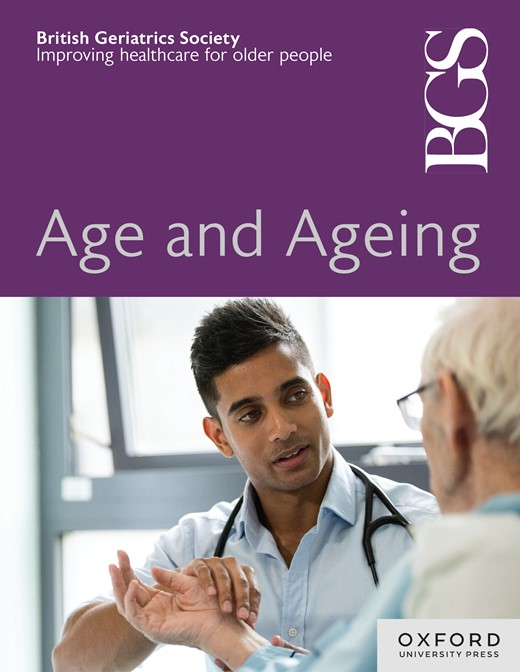Frailty assessed by a wrist-worn device can predict hospitalisation and mortality in middle-aged and older adults: a UK Biobank study
IF 7.1
2区 医学
Q1 GERIATRICS & GERONTOLOGY
引用次数: 0
Abstract
Background Digital gait biomarkers (DGBs) from wrist-worn devices may offer a simple, convenient method for assessing frailty; however, their clinical validity has not been sufficiently verified. This study aimed to determine whether frailty assessed using DGBs is not inferior to the Fried frailty phenotype for predicting hospitalisation and mortality. Methods This longitudinal study included 10 156 adults (aged 43–81 years) with complete Fried frailty phenotype and DGB data from the UK Biobank. DGBs were extracted using validated algorithms on raw data from wrist-worn accelerometers over 7 days. DGB frailty was derived from DGBs and the Fried frailty phenotype. Results First hospitalisations and deaths were followed for 4.4 ± 2.7 and 7.2 ± 0.7 years, respectively. In these periods, 6148 (60.5%) were hospitalised (44 277 person-years follow-up) and 270 (2.7%) died (73 312 person-years follow-up). Cox proportional hazards models, adjusting for confounders, showed that both Fried and DGB frailties were predictive of hospitalisation (hazard ratios and 95% confidence intervals [CIs]: 1.29 [1.13–1.47] versus 1.33 [1.17–1.52]) and mortality (1.63 [1.01–2.62] versus 1.77 [1.14–2.74]). The mean differences (DGB frailty–Fried frailty) and 95% CIs in Harrell’s C-index for hospitalisation and mortality were 0.000 [−0.002 to 0.001] and 0.002 [−0.004 to 0.009], respectively, with the lower limit of the 95% CIs exceeding the prespecified noninferiority margin (−0.1). Conclusion DGB-derived frailty predicted hospitalisation and mortality and was not inferior to the Fried frailty phenotype. These findings support the clinical validity and potential utility of wearable devices in the assessment of frailty in clinical practice.英国生物银行的一项研究表明,通过佩戴在手腕上的设备评估的虚弱程度可以预测中老年人的住院治疗和死亡率
来自腕戴设备的数字步态生物标志物(DGBs)可能提供一种简单、方便的评估虚弱的方法;然而,其临床有效性尚未得到充分验证。本研究旨在确定使用DGBs评估的衰弱在预测住院和死亡率方面是否优于Fried衰弱表型。方法这项纵向研究包括10156名成年人(43-81岁),他们有完全的Fried脆弱表型和来自英国生物银行的DGB数据。使用经过验证的算法从腕式加速度计的原始数据中提取dgb超过7天。DGB脆性来源于DGBs和Fried脆性表型。结果首次住院时间为4.4±2.7年,死亡时间为7.2±0.7年。在此期间,6148人(60.5%)住院(随访44 277人-年),270人(2.7%)死亡(随访73 312人-年)。Cox比例风险模型在调整混杂因素后显示,Fried和DGB脆弱性均可预测住院(风险比和95%置信区间[ci]: 1.29[1.13-1.47]对1.33[1.17-1.52])和死亡率(1.63[1.01-2.62]对1.77[1.14-2.74])。住院和死亡率的Harrell 's c指数的平均差异(DGB衰弱- fried衰弱)和95% ci分别为0.000[- 0.002至0.001]和0.002[- 0.004至0.009],95% ci的下限超过预定的非劣效性界限(- 0.1)。结论dgb衍生的虚弱预测住院率和死亡率,且不逊于Fried虚弱表型。这些发现支持了可穿戴设备在临床实践中评估虚弱的临床有效性和潜在效用。
本文章由计算机程序翻译,如有差异,请以英文原文为准。
求助全文
约1分钟内获得全文
求助全文
来源期刊

Age and ageing
医学-老年医学
CiteScore
9.20
自引率
6.00%
发文量
796
审稿时长
4-8 weeks
期刊介绍:
Age and Ageing is an international journal publishing refereed original articles and commissioned reviews on geriatric medicine and gerontology. Its range includes research on ageing and clinical, epidemiological, and psychological aspects of later life.
 求助内容:
求助内容: 应助结果提醒方式:
应助结果提醒方式:


